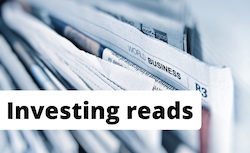I was browsing a list of ETFs the other day, as you do, when I stumbled upon something I’ve been waiting a very long time for: a global small cap value ETF.
Value stocks are the subset of risky stocks that are deemed ‘undervalued’ by investors.
According to the value thesis, these ugly ducklings are excessively shunned, lowering their price relative to their potential.
Hence, you can pick them up for a song, Moneyball style, and wait for them to outperform the market over time as their true worth is realised.
But the risk premium associated with value – the performance bonus potentially available beyond the market return – is overwhelmingly concentrated in the small cap corner of the stock universe.
This means you can only really expect value to pay off when you invest in firms that are both smaller and cheaper on balance.
We can verify this using long-run data going back to 1927. The record shows that long-only US small cap value beat the US market by 2% per year on average.
Value works in other world markets too. I’ll post some charts in a follow-up post.
For now, I’ll just comment that there’s no reason to think the value premium is dead, though it’s underperformed in the US since 2013.
The data also confirms that large cap value does not deliver – at least not in the long-only form we can invest in.
Small bargains
Ideally then, to capitalise on the value premium we’d invest in:
- A small cap value fund
- That’s globally diversified
- With an investing approach backed by credible independent research
- Including techniques to mitigate the drawbacks of real-world value strategies
- That’s accessible to anyone for a reasonable fee
It’s always been impossible for UK DIY investors to tick all those boxes – until now.
The Avantis Global Small Cap Value ETF (AVSG) checks them all. So much so that I invested in it before finishing this review!
Hopefully by the time your patience runs out I’ll have explained why I’m so impressed.
What makes for a strong small cap value fund?
We want a fund that:
- Captures size and value traits as purely and consistently as possible, using sound definitions of the factors.
- Incorporates mechanisms such as a profitability screen to try to filter out undesirable value stocks.
- Combats style drift – that is, the tendency for stocks to move out of the small cap value part of the spectrum as they rise in price.
- Diversifies your overall portfolio. (If your chosen value ETF is full of Cisco Systems, Toyota, HSBC, and Shell, then it probably overlaps significantly with your global tracker fund, and so offers a diluted version of the factor.)
- Clearly articulates a transparent investment process for reliably doing all this.
- Keeps costs down.
We should also be able to use widely accepted valuation metrics to check that the fund is doing its job.
The AVSG ETF delivers on all of those points. I’ll show you how with some data in a sec.
What about track record?
Track record is the glaring omission from my criteria above.
Aren’t returns important?
Yes, once we have five years worth of results (and ideally much more) we can test a fund against its direct competitors.
But AVSG only launched in September 2024. Hence there’s no way to pit it against rivals in a worthwhile apples-to-apples performance contest.
Moreover, the UK’s Soviet-style supermarket of small value funds means we’d be comparing an apple with a turnip, one mouldy potato, and a suspicious-looking purple thing.
Happily though Avantis has been operating in the US since 2019. The consensus from the critics has generally been a big thumbs-up, and investors have rewarded the brand by moving billions into Avantis ETFs.
What’s more, we can try to reassure ourselves that AVSG specifically won’t prove to be a lemon in the UK by checking how its US-domiciled equivalents have fared since their launch in September 2019.
That’s possible because AVSG covers the same territory as two US ETF stablemates:
- Avantis International Small Cap Value (AVDV)
- Avantis US Small Cap Value (AVUV)
Let’s match those two ETFs against their competitors using the amazing Portfolio Visualizer tool to see how they’ve performed.
International small cap value face-off
Avantis’ main rival in this category is Dimensional Fund Advisors (DFA):

It’s a dead heat! The annualised nominal USD returns for the two funds over the longest comparable time frame (October 2019 to end of April 2025) were:
- Avantis’ AVDV: 10.17%
- DFA’s DISVX: 10.25%
DFA has been the acknowledged master of the investible value factor since the early 1990s. Matching the DFA fund from launch is no mean feat.
And while DFA funds are available in the UK, that’s only via financial advisors.
This frustrating situation may be changing – the firm is advertising for ETF roles in Europe. Previously DFA has made its funds available to the wider American public in ETF form, too.
But for now the DFA funds are no-go in the UK if you’re going it alone.
US small cap value face-off
Focusing specifically on the US, Avantis bossed a wider field of contenders in this category:

Again these annualised returns hail from the longest time period available, October 2019 until end of April 2025: 1
- Avantis’ AVUV: 11.1%
- DFA’s DFSVX: 10.0%
- Vanguard’s VBR: 8.3%
- iShares’ IJS: 5.3%
These results, plus the products’ underlying metrics and the analysis of Avantis’ ETFs by noted US commentators such as Allan Roth and Larry Swedroe – not to mention the well-informed Bogleheads community running a slide rule over them, too – dispels any concern I have about Avantis being an unknown quantity.
The Avantis funds are doing an excellent job in the US and I have no reason to think they won’t do the same in Europe.
Is AVSG a good small cap value ETF?
I believe AVSG is the real deal, and I think we can independently verify its small cap value credentials using data aggregator Morningstar.
Morningstar provides the only way I know of to compare the factor exposures of funds available to UK investors.
First, go to the Portfolio page of AVSG’s Morningstar profile.
Then check out the Stock Style section:

The bulk of AVSG is found in the small value square of the grid.
Excellent!
That’s better than DFA’s Global Targeted Value fund:

You can see that DFA’s fund isn’t as small value-y as AVSG.
ZPRV, the SPDR MSCI USA Small Cap Value ETF, does contain more small value exposure:

However it’s 100% US and hence less diversified. (You can pair ZPRV with ZPRX for the European dimension, but you’re still not covering as much of the planet and with twice as much hassle.)
Finally, here’s the iShares Edge MSCI World Value Factor ETF (IWVL):

IWVL is globally diversified. But its stock style reveals it to be a large value ETF. Historical returns tell us we can’t expect large value to deliver a significant risk premium.
All told, I think the Stock Style survey shows that AVSG’s small value chops are worthy of further investigation.
AVSG’s fundamental valuation metrics
I also want to check that AVSG scores well on a range of commonly accepted value metrics.
Morningstar does the honours once more:

The lower the scores in the green box, the more value-y the fund is. And AVSG does well again – outranking ZPRV and DFA’s fund, though I won’t trouble you with their screenshots.
Remember, we’re not looking for absolute numbers or particular thresholds. The metrics are useful insofar as they enable us to assess AVSG versus comparable choices.
Ignore the category and index numbers if they’re inappropriate. In this case, Morningstar has served up off-point small / mid cap benchmarks, skipping the value side of the coin.
Hit the Market Cap button in the Style Measures section to see the average market cap of the fund’s holdings.
We want this number to be teenier than thou to confirm the fund’s small cap credentials:
| Fund | Av market cap ($bil) |
| AVSG | 2.09 |
| DFA Glb Targ Val | 5.37 |
| ZPRV | 4.07 |
As the picture builds, AVSG looks bang on the small value money.
So shall we call it a day?
Unfortunately the value trap lies in wait.
Avoiding the value trap
A value trap is an investment that looks like an absolute bargain. It lights up the valuation metrics because it’s cheap.
But it’s cheap for a reason. The reason is it’s junk.
Good value funds and indexes sieve the rubbish with a profitability screen.
We can get some sense of how well AVSG does this via the quality measure in Morningstar’s Factor Profile:

Quality is a variant of profitability. AVSG’s quality score is higher than DFA’s comparable fund, and DFA is well-respected for using profitability screens to enhance value funds.
Ignore the fact that the quality score looks objectively low and is below the category average.
You wouldn’t expect a small value fund to score highly for quality, and the category benchmark is off as previously mentioned.
All I’m looking for is evidence that AVSG’s stocks aren’t scraped off the bottom of the bargain bin. Its quality score of 77 (the 77th percentile for quality in Morningstar’s stock universe) offers some comfort on that front.
DFA’s fund lies in the 85th decile for quality. It holds even less in the way of profitable companies – yet DFA’s value funds set the standard for the industry.
Morningstar doesn’t score ZPRV but IWVL (iShares’ large value effort) also floats around the 85th decile. So in comparison to other value funds, AVSG looks, well, quality.
Negative momentum
Momentum exposure is also worth an eyeball.
Team Avantis describes how value funds can be adversely affected by negative momentum. (Monevator articles can also suffer from this phenomenon.)
Picture a stock dropping in price. This price slashing can place a stock firmly in the value zone per traditional measures such as price/earnings, price/book, and so on.
But the chief insight of the momentum thesis is that stock price declines (and gains) typically continue for some time.
Why rush into catching a falling knife when it’s probably got further to go? Better to buy it closer to the bottom and then hope to cash in if and when it finally ascends.
Avantis attempts to harness momentum by delaying purchases with large negative six-month returns and, conversely, the sale of stocks with large six-month gains.
You would expect a value vehicle to score quite poorly for momentum. DFA’s fund is 84th decile.
But AVSG is 60th decile, which suggests it’s succeeding in dampening down negative momentum.
The light blue shading in AVSG’s Factor Profile above reveals each exposure’s historical range. You can see its momentum score is swingy.
But the lack of shade in the style 2 and size categories shows the fund has remained firmly rooted in its target factors. It has not been afflicted by style drift since its launch.
Taken together, AVSG’s metrics suggest it’s a top-notch small value ETF.
What on Earth are they up to?
The Avantis team has written an excellent guide to its methodology called Our Scientific Approach To Investing.
ETF providers rarely write such a clear explanation of their investing process.
The major firms pump out scanty marketing gloss that typically leaves me wondering if they think their customers are idiots.
Or they produce indecipherable exercises in obfuscation, designed to make you think you are an idiot.
In comparison to those poles of customer disservice, the Avantis paper is a masterclass in transparency.
Granted, they’re not telling you where all the bodies lie. But they do explain what they’re doing and why.
It makes sense relative to my grasp of the academic literature, and you can follow the citations to sanity check any aspect of the strategy.
I won’t regurgitate the paper but it’s well worth a read if you’re interested in this ETF. It reinforced my sense that AVSG is a good choice for a world small cap value fund.
(Not to mention the only one!)
Closing remarks on AVSG
Avantis is a sub-brand of global asset manager, American Century. American Century appears to be reasonably well-regarded, while Avantis was spun-up by ex-DFA executives – no doubt explaining the impressive value fund execution.
AVSG’s 0.39% OCF is not cheap, but it’s not expensive for what it is either. I wouldn’t think twice about that price tag if I wanted small value exposure.
It’s an actively-managed ETF so it doesn’t track an index. That’s how DFA funds work too, and it appears to be an advantage in this category.
The ‘global’ moniker means developed world really. Emerging markets are excluded.
Still, AVSG is amply diversified with 1,300 stocks. Check out the holdings and you’ll quickly see there’s no danger here of replicating your global tracker positions.
Scan the sectors and you’ll also see useful differences. For example, AVSG is just 5% tech versus 25% in Vanguard’s Developed World ETF (VEVE).
The Avantis fund won’t reduce your US exposure – but it may help if AI-driven large caps falter.
Diversifying your sources of return like this paid off handsomely when tech stocks imploded during the Dotcom bust. The S&P 500 dived -38% in those years. Meanwhile US small cap value advanced 19%. 3
Still, who knows whether that will happen again? Or if small value will outpace the wider market in the future?
Moreover AVSG is liable to give you a rough ride along the way. Check out the volatility measure above.
Indeed the reason small value is expected to earn market-beating returns is because it loads up on very risky stocks. Thus AVSG is not for the faint-hearted or anyone who doesn’t know how they react to stock market reversals.
Pros
- Excellent example of a small cap value fund
- The only globally-diversified iteration available to UK investors without jumping through DFA hoops
- Metrics look good
- Well conceived and clearly documented investment process
Cons
- There’s no guarantee small cap value will outperform the market. In fact it hasn’t for over a decade.
- It’s risky!
Take it steady,
The Accumulator




